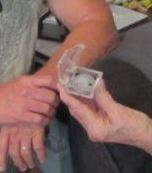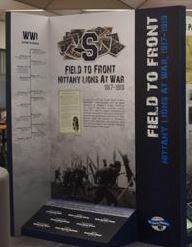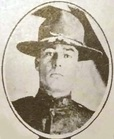“Bells of Peace” takes place at the new National WWI Memorial in Washington, D.C. for first time 11/11/21 at 11:00 EST
Since the centennial of the WWI Armistice in 2018, The Bells of Peace have been tolled in remembrance at 11am on Veterans Day. The national bell tolling commemorates the World War I Armistice – which happened on November 11, 2018 when the guns fell silent, and bells tolled on the Western Front after four years of brutal combat.
Each Veterans Day since 2018, Bells of Peace participants have taken a few moments at the 11th hour local to remember those who served in WWI with a remembrance of a 21-peal bell tolling. Tens of thousands have participated in this ritual including states, cities, municipalities, ships, military installations, churches, schools, veterans’ organizations, museums, and individuals.
For the first time, this year “Bells of Peace” will remember those who served with a ceremony at the National WWI Memorial in Washington, D.C. Click here to read more, and learn how you can participate in Bells of Peace wherever you are on November 11 -- even if you don't have a bell.
"The Hello Girls of WWI deserve to be recognized for their place in history."

There were a lot of surprises for everyone in the case of the recovered World War I dog tag of U.S. Army Pvt. William Larkin Villines in Texas. First, Tracy McLoud of Belton was surprised when her metal detector led her to dig up the disc. She’d been over that ground before, she said. Then, she was surprised when, with the help of her sister, Stacy McLoud, and a friend, Roxann Patrick, she was able to identify the owner of the dog tags and locate his daughter, Perrie Bigham, 85, who lives in Temple. Click here to read more, and learn how the most surprised person of all was Bigham herself.
|

A mobile exhibit on display in the Penn State DuBois Library this semester tells the story of Penn State athletes who served the United States during World War I. Titled “Field to Front," this mobile display was created by the team at the Penn State All-Sports Museum at University Park, and will be open to the public in the campus library for the entire fall semester. During the course of World War I, 2,155 Penn State students, faculty, and alumni entered the military. Of these, 73 lost their lives with the majority falling due to enemy action. Among the over 200 former varsity lettermen who served, seven were killed in combat while an eighth was lost in a training accident shortly after the end of the war. Click here to read more, and learn how the Field to Front exhibit recognizes the service and sacrifice of these individuals.
|

The year-long celebration of the 100th anniversary of the Burlington County Library System (BCLS) will culminate in October with a collection of activities, programs and events designed to mark the important milestone. Branch events and activities include an Oct. 14 lecture about the U.S. Army Signal Corps telephone switchboard operators, also known as the “Hello Girls” and their importance to battlefield communications during World War I and their fight for veterans status. Click here to read more, and learn how to attend this and other events marking the library system's centennial.
|

The Purple Heart awarded to a World War I soldier was returned to his great nephew Purple Hearts Reunited. 78-year-old Jake Neta, Vietnam Veteran, U.S. Army, received his great uncles purple heart at the “return ceremony” in Lena, WI. PFC John Francis “Dutch” Hansel of Medford, WI served in the 32nd Infantry Division when he was wounded in World War I. His Purple Heart Medal and World War I Victory Medal were found in someone else’s home when they were moving out. “I was kind of surprised because I had no knowledge of my great uncle being in the service,” said Neta. Click here to read more, and learn what else the WWI veteran's family discovered about Hansel's service in World War I.
|

A man is only missing if he is forgotten.
Our Doughboy MIA this month is Private Wesley J. Creech. Born 15MAR1886, in Hallsboro, North Carolina, Wesley Jackson Creech was the fourth of six children that Henry and Martha Creech would rear. He signed his 05JUN1917 draft card at Bolton, North Carolina, where he listed himself as a lumber inspector and two months later married Miss Francis Williamson, age 19.
Creech received his draft call shortly thereafter, reporting for duty on 01OCT1917 and was sent to Camp Jackson for induction. From there he went to Camp Sevier for infantry training, and was placed in Company C, 120th Infantry Regiment, 30 the ‘Old Hickory’ Division.
Departing Boston, Massachusetts for overseas service on 12May1918 aboard the transport Bohemian, Creech’s division was brigaded with the British in the Somme sector that summer.
Records show Wesley Creech as being killed in action on 31AUG1918 and buried by a British unit; however, later identification of his grave by American Graves Registration personnel proved fruitless. As such, he is memorialized on the Tablets to the Missing at the Flanders Field American Cemetery at Waregem, Belgium.
Want to help solve Pvt. Creech’s case? Consider making a donation to Doughboy MIA at www.usww1cc.org/mia. It takes only a moment and your tax deductible contribution can be as large as you want, or as small as $10.00 on our ‘Ten for Them’ program. Your contribution helps us make a full accounting of all 4,423 US MIA’s from WWI, and keeps these lost men from being forgotten. Make your tax deductible donation now, with our thanks.
A man is only missing if he is forgotten.
|
Merchandise from the Official
Doughboy Foundation WWI Store

- A Doughboy.shop Exclusive!
- This replica tin mug has been upcycled into an all-natural soy candle
- Candle filled by Charleston Candleworks (USA)
- Made from all organic soy wax, cotton wick, essential oils
- The “Morning Java” scent will fill the room with a wonderful coffee aroma that includes just a hint of chocolate.
- Camp mug is reusable once the candle has burned down
- Makes a great 2-in-1 gift. (Reduce + Reuse)
Proceeds from the sale of this item will help build the new National World War I Memorial in Washington, DC.
This and many other items are available as Official Merchandise of the Doughboy Foundation.
|
|